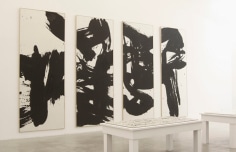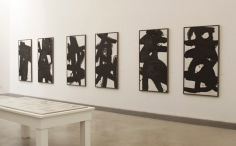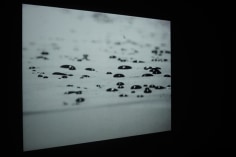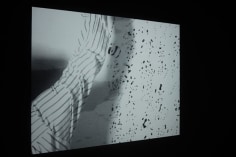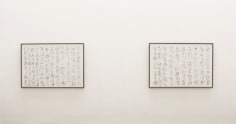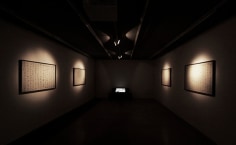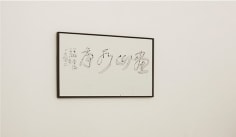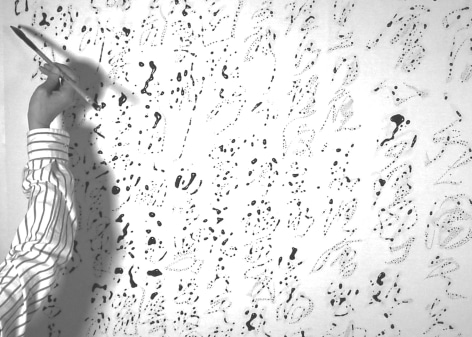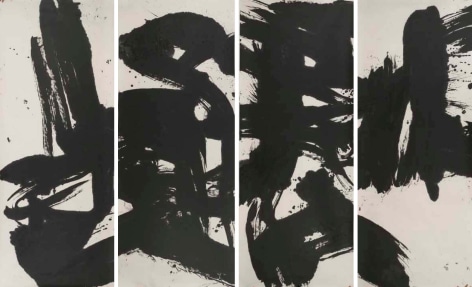Chambers Fine Art is pleased to announce the opening on July 13, 2013 of Guanshan Gathering: Works by Zheng Shengtian and Wang Dongling. This collaboration between the influential scholar, curator and artist Zheng Shengtian and the highly regarded calligrapher Wang Dongling is the first time that they have worked together although they have formed close ties through their long-standing affiliation with the China Academy of Art in Hangzhou.
Born in 1938, Zheng graduated from the Zhejiang Academy of Art (now China Academy of Art) in 1958 and was a professor and chair of the oil painting department for over thirty years. In addition to his academic activities and energetic promotion of contemporary art from China, notably as managing editor of Yishu: Journal of Contemporary Chinese Art since 2002, Zheng has continued his own artistic practice both as a painter and in more conceptually oriented works.
Born in 1945, Wang Dongling’s studies at Nanjing Normal University were interrupted by the Cultural Revolution but he resumed his studies at the Zhejiang Academy of Art and received his MFA degree in 1981. He has been associated with this prestigious institution ever since, and is currently a professor, doctoral supervisor and Director of the China Academy of Art Modern Calligraphy Research Center.
The current collaboration between the two artists uses as model a video-installation that Zheng Shengtian contributed to the exhibition Word and Meaning: Six Contemporary Chinese Artists at SUNY Buffalo and Ohio University in 2000-2001. Using Clement Greenberg’s canonical essay “Modernist Painting” as text, Zheng made a video of his wife Aikang writing in ink on canvas accompanied by a soundtrack of the Canadian artist Hank Bull reading the essay. The four canvases were also included as part of the installation. As a result of the incompatibility of the water-based ink and the prepared surface of the canvas, the ink marks shrank until only a pattern of irregular dots remained, reminiscent of an abstract painting. The gradual deprivation of Greenberg’s words of meaning in the process of painting re-enacted the historical progress of Modernist Reductionism that Greenberg believed to be inevitable.
Earlier this year Zheng changed the parameters of his analysis of the relationship between mark and meaning by choosing Zong Bing’s fifth–century classic Introduction to Landscape Painting as text and a celebrated contemporary calligrapher, Wang Dongling, as executant while maintaining his detached attitude to the behavior and significance of ink as medium. As the irregularly prepared canvases, five in all, rebuffed Wang’s highly trained gestures, a video camera recorded the entire process.
The installation at Chambers Fine Art will be divided into three sections. One gallery will be devoted to the video made in Hangzhou in April, 2013 and the five panels executed by Wang Dongling. In another gallery recent works by Wang Dongling will be displayed as well as two large canvases which he will paint in public at the opening on July 13. In the small gallery, the video made in 2000 will be shown as well as the four canvases that were exhibited on that occasion.
The Guanshan Gathering of Zheng Shengtian and Wang Dongling may be seen as an erudite dialog between two well-seasoned artist /scholars, one in which Wang’s modernist calligraphy is examined by Zheng in a conceptual context that dates back to his first consideration of these issues in 2000.
北京前波画廊荣幸地宣布将于2013年7月13日起举办《冠山风:郑胜天与王冬龄作品展》。集学者、策展人及艺术家为一身的郑胜天与书法大师王冬龄分别与中国美术学院有着很深的感情,两人也因此互相保持着紧密的联系,但此次在前波画廊的展览却是两位大师在艺术创作上的首次合作。
郑胜天于1938年出生,1958年毕业于浙江美术学院(现中国美术学院),并任教兼油画系主任三十余载。除了学术方面的成就,郑也在海外积极推广中国当代艺术,并于2002年起任中国当代艺术学刊《艺术》(Yishu)的主编。同时,郑胜天也一直坚持着自己的艺术创作,其中不仅包括油画,更重要的是其观念作品。
王冬龄于1945年出生,他在南京师范大学的学习受到了文革的影响,之后又在浙江美术学院继续深造并于1981年获得书法硕士学位。自那时起他便与这所名校结下了不解之缘,现任中国美术学院现代书法研究中心主任、教授、博士生导师。
此次两位艺术家的合作利用了郑胜天2000年的一件作品作为创作理念。当时,郑胜天为纽约州立大学水牛城分校和俄亥俄大学于2000-2001年举办的展览《文字与含义:六位当代中国艺术家》创作了一件影像装置作品。影像记录了太太爱康用毛笔蘸墨在四幅油画布上书写克莱门特 • 格林伯格的权威性文章《现代主义绘画》的过程,同时配有加拿大艺术家卜汉克英文同步朗读正在书写的文字。放映影像的同时,也展出了那四幅画布。由于水墨与油互不相容,写上去的字迹很快便凝聚起来,不一会儿就只剩下一些不规则的斑点,好似幅抽象画一般。当格林伯格“文字”的“含义”在画布上逐渐消逝的同时,他所坚信的现代主义绘画还原论似乎又得到了再现。
今年春天郑胜天在杭州冠山再一次探索“文字”与“含义”之间的关系。此次他将题材改为东晋宗炳的经典名作《画山水序》,并邀请著名当代书法家王冬龄来书写全文。同时,郑胜天依旧保持着自己对水墨这一重要媒材的客观、独立的态度。用油不均匀处理过五幅油画布后,王冬龄龙飞凤舞地书写了宗炳的文字,一部录影机记录了这整个创作过程。
此次在前波画廊的展览共分三部分。一间展厅将展示2013年4月的影像作品以及由王冬龄书写的5幅油画布作品。另一展厅中,王冬龄将于7月13日展览开幕当天在两幅油画布上作现场表演,完成的作品将留在展厅中央,周围也将展示他的其他书法作品。小展厅中将放映郑胜天2000年的影像作品,并展示那四幅油画布作品。
郑胜天与王冬龄在杭州冠山的雅集可被视为两位艺术家、学者之间的一次学术对话。通过王冬龄的现代书法,他们再次挑战了郑胜天2000年首次提出的观念和问题。

